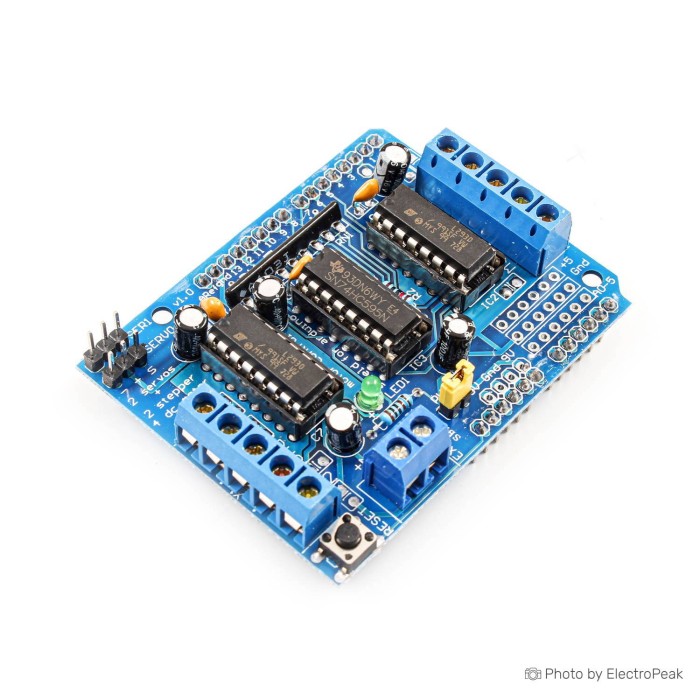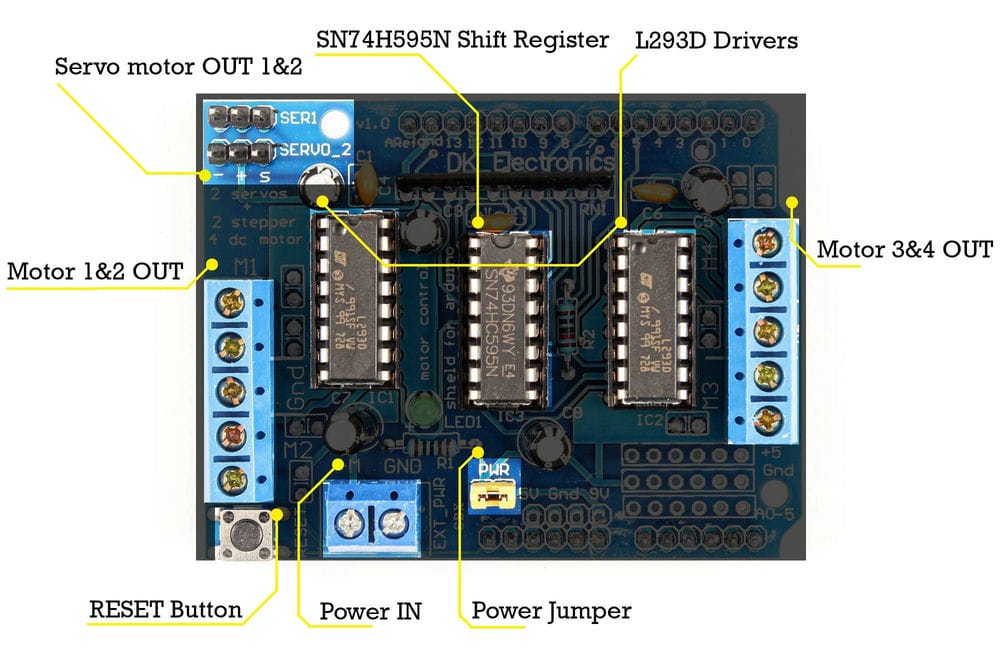L293D Motor Driver Shield for Arduino
Volume discounts:
- +100 7 % $1.4000
- +300 9 % $1.3600
- +500 11 % $1.3300
- +1000 14 % $1.2900
-
L298N Dual-Channel DC/Stepper Motor Driver
MTR-09-003 -
L298N Dual-Channel Bipolar DC/Stepper Motor Driver
MTR-09-001 -
7A 160W Dual Channel DC Motor Drive Module (Replac
MTR-08-023 -
L293D Motor Driver Shield for Arduino
ARD-02-044 -
L298P H-bridge Arduino Motor Driver Shield with Bu
ARD-02-003 -
L298P Dual Channel Arduino Motor Driver Shield
ARD-02-002
 W5100 R3-2013 Ethernet Shield for Arduino
Previous
W5100 R3-2013 Ethernet Shield for Arduino
Previous

If you want to run a motor using a microcontroller, you need to use motor drivers. Because microcontrollers do not have the ability to supply enough current to start the motors. One of the most famous motor drivers is L293D IC. The L293D is a popular motor driver IC (Integrated Circuit) that is widely used for controlling DC, stepper and servo motors. It is often employed in robotics, electronic projects, and other applications where precise control of motor movement is essential.
Key features of the L293D Motor Driver Shield for Arduino:
- H-Bridge Configuration: The L293D is designed as an H-bridge, which is a circuit arrangement that allows control of the direction of rotation of a DC motor. H-bridges are commonly used to drive motors in both forward and reverse directions.
- Bidirectional Control: The H-bridge configuration enables bidirectional control of the connected DC motor. This means you can make the motor rotate in both the clockwise and counterclockwise directions.
- Dual Motor Control: The L293D typically comes with two H-bridge circuits in a single IC package, allowing it to control two DC motors independently. Each motor can have its speed and direction controlled.
- Input Compatibility: The L293D is compatible with microcontrollers like Arduino, making it easy to interface with these controllers. It can be controlled using digital signals from the microcontroller to determine the motor's speed and direction.
- Built-in Diodes: The IC incorporates built-in diodes to protect the circuit from back EMF (electromotive force) generated by the motor when it is turned off. These diodes help prevent damage to the circuit due to voltage spikes.
- Current Handling: The L293D has a specified maximum current it can handle per channel. This parameter is important to consider when choosing a motor to ensure it does not draw more current than the IC can handle.
- Versatility: While commonly used with DC motors, the L293D can also be employed to control other types of loads, such as solenoids.
Specifications of the L293D Motor Driver Shield for Arduino:
- Motor Driver Type: Dual H-Bridge motor driver.
- Motor Channels: 2 channels per IC, allowing control of 4 DC motors or two stepper motor.
- Maximum Motor Current: Up to 0.6A per channel.
- Voltage Range: Typically designed to operate with a supply voltage between 4.5V and 36V.
- Logic Voltage (Vcc): Usually operates at 5V for logic control.
- Built-in Diodes: Contains built-in flyback diodes for motor protection against back EMF.
- Control Interface: Typically controlled using digital signals, compatible with Arduino boards like Arduino UNO, MEGA and DUE.
- H-Bridge Configuration: Configured as an H-bridge for bidirectional control of DC motors.
- Package Type: 16-pin DIP (Dual Inline Package).
- Current Sensing: Some variations might include current-sensing capability.
- Size: 68mm x 55mm x 20mm
L293D motor driver shield components
The L293D motor driver shield is equipped with two L293 motor driver ICs and a 74HC595 shift register IC. It incorporates several crucial components.
- Motor Driver: The L293D serves as a dual-channel H-bridge motor driver, capable of managing two DC motors or a stepper motor simultaneously. With two L293D ICs on the shield, it can technically oversee a total of four DC motors, making it well-suited for both two and four-wheel robot platforms. Each H-bridge in the IC can deliver up to 0.6A to a motor.
- Shift Register: The 74HC595 is an 8-bit serial input and serial/parallel output shift register. Its purpose is to expand four Arduino GPIO (or another microcontroller) to eight direction control pins for two of the L293D motor driver ICs.
- Power Supply: The shield's power supply can be utilized for both the shield and Arduino, or they can have separate power sources. In the case of a shared power supply, a power jumper must be placed on the shield. The power can be derived from Arduino's USB port, its DC jack, or from the shield's 2-pin EXT-PWR block.
- The reset button: The shield has a reset button at its bottom left corner. It is only the Arduino™s reset button brought up at the top of the shield for use
In scenarios where separate power supplies are employed, it is imperative not to engage the power jumper on the shield. Instead, the shield's 2-pin EXT-PWR block should be utilized, and Arduino can still be powered by connecting to its USB or DC jack.
Use Cases of L293D motor driver shield for Arduino:
The L293D motor driver shield is widely used in various electronic projects, especially those involving motor control. Some common use cases for the L293D motor driver shield include:
- Robotics Projects: L293D is often used in robots with two or four wheels, where it can control the movement of DC motors powering the wheels. In robotic arms and grippers, L293D can be employed to control the motors responsible for the arm's movement.
- Smart Vehicles: L293D is utilized in remote-controlled cars and drones to manage the motors responsible for propulsion and steering. In small-scale autonomous vehicles, L293D can be used for motor control in applications such as obstacle avoidance.
- Home Automation: L293D can be incorporated into systems that automate the opening and closing of curtains or blinds. Also It can be used for controlling motors in automated door or gate systems.
The L293D can generate heat, especially at higher currents. Consider adding heat sinks to the L293D to dissipate heat more effectively. Additionally, ensure proper ventilation in your setup.




.jpg)


Please complete your information below to login.
Sign In
Create New Account